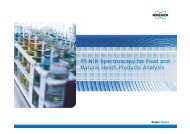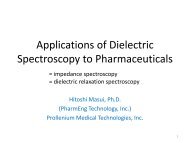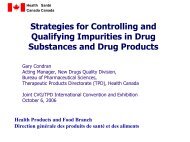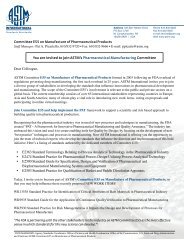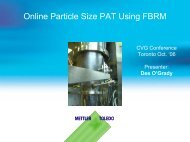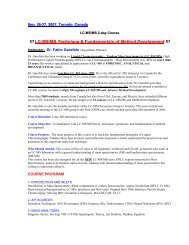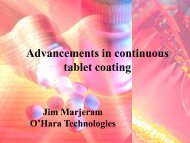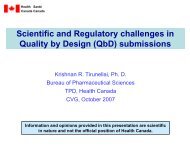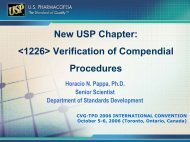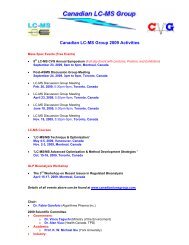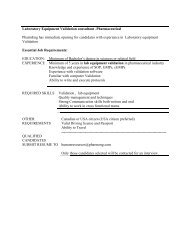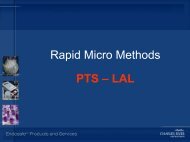Compendial Harmonisation - CVG
Compendial Harmonisation - CVG
Compendial Harmonisation - CVG
Create successful ePaper yourself
Turn your PDF publications into a flip-book with our unique Google optimized e-Paper software.
Impact of non-harmonisation◦ Redundant, non-value addedtesting• No benefit to patient• Waste of time and resources• Does not impact quality or safety◦ Quality cannot be tested in◦ Inconsistent with the “sciencebased”and “risk-based” approach10
Can talk in some detailtoa friend aboutsomething one justbought, such as anelectronic dictionary,while comparing itwith 電 the 子 辞 書 device など、 新 しくone買 い 替 えた 物 について、previously had.前 に 持 っていた 物 とくらべながら、ある 程 度 詳 しく 友 人 に話 すことができる。Can introduce in somedetail the functions ofthe equipment,production processes,etc., when giving aguest a tour of a factorybelonging to one’scompany.来 客 に 自 分 の 会 社 の 工 場などを 案 内 するとき、機 会 の 機 能 や 生 産 過 程 などを、ある 程 度 詳 しく 紹 介 することができる。
PDG Stages◦ Stage 6: Regional Adoption andImplementation• 6A – Adoption◦Each pharmacopoeias incorporatesharmonised draft according to their ownprocedure◦Adopted texts are published by eachpharmacopoeia in a supplement or newedition◦If needed, the Stage 5B draft amended withlocal requirements18
PDG Stages◦ Stage 6: Regional Adoption andImplementation• 6B – Implementation◦ Pharmacopoeias notify each other of theirspecified implementation date• 6C – Indication of harmonisation◦ Each pharmacopoeia has published and madethe text official◦ Stage 7: Inter-regional acceptance• Date of this stage will be common amongst allthree pharmacopoeias• Assigned after receiving notification from ICHQ4B19
PDG Progress◦ General Chapters at Stage 6(refer to handouts for regional and interregionalimplementation targets)• Dissolution• Disintegration• Uniformity of Content/Mass• Microbial Enumeration• Microbial contamination limits for non-sterile products• Extractable Volume of Parenterals• Test of Particulate Contamination: subvisible particles• Residue on Ignition• Sterility Test• Analytical Sieving• Flowability / Powder Flow• Tablet Friability• Optical Microscopy• Specific Surface Area20
PDG Progress◦ Excipients at Stage 6(refer to handouts for regional and inter-regionalimplementation targets)• Benzyl Alcohol• Calcium Disodium Edetate• Calcium Phosphate Dibasic (and anhydrous)• CMC Calcium• Croscarmellose Sodium• Microcrystalline Cellulose• Cellulose, Powered• Cellulose Acetate• Cellulose Acetate Phthalate• Citric Acid, Anhydrous and Monohydrate• Ethylcellulose• Hydroxypropylmethylcellulose• Lactose, monohydrate21
PDG Progress◦ Excipients at Stage 6 (continued)(refer to handouts for regional and inter-regionalimplementation targets)• Magnesium Stearate• Methylcellulose• Methyl Paraben, Ethyl Paraben, Propyl Paraben,Butyl Paraben• Saccharin• Saccharin Sodium• Saccharin Calcium• Sodium Chloride• Sodium Starch Glycolate• Starch, Corn Starch, Potato Starch, Wheat• Talc22
PDG Process◦ Process Concerns• Process is slow• Collaboration occurs too late in the process• Public consultation occurs too late in the process◦ Results:• Long delays• Lack of progress• Conflicting comments from around the globe◦ Effect• Frustration of all involved!23
Developments in ICH24
ICH Q4B Background and Information◦ What is ICH Q4B?• Regulatory Acceptance of AnalyticalProcedures and Acceptance Criteria• Members◦ EU/Japan/US Regulators;EFPIA/PhRMA/JPMA• Observers◦ WSMI, IGPA, WHO, Health Canada25
ICH Q4B Background and Information◦ Purpose:• Facilitate the regulatory acceptance ofPDG-harmonised texts• Clearly indicate the regulatoryinterchangeability status for each ofthe regulatory regions• Indicate the effective date forinterchangeability• Expedite the implementation ofinterchangeability26
ICH Q4B Background and Information◦ Why is it necessary?• PDG was making progress• Regulators were not part of the PDG process• Industry concern regarding regulatory acceptance• Pharmacopoeial published texts may not be identical tothe “PDG sign-off” text◦ may require interpretation• Need confidence that harmonised text is based on anassessment that is unambiguous, transparent and assuresthat sound science has been applied27
ICH Q4B Background and Information◦ Focus• 11 General Test Chapters linked to ICH Q6A◦ Dissolution◦ Disintegration◦ Content Uniformity◦ Extractable Volume of Parenterals◦ Particulate Matter in Injectables◦ Sterility◦ Microbiological Quality◦ Bacterial Endotoxins◦ Sulphated Ash / Residue on Ignition◦ Colour of Solution◦ Clarity of Solution28
ICH Q4B Background and Information◦ PDG Commitments• Goal to have the final version of theregional texts available at Stage 5B signoff• Minimise change to the harmonised textonce “signed off”• Notification to ICH Q4B EWG of anyunavoidable changes to the text• Explore methods to reduce time to achieveofficial status of final implementation29
ICH Q4B Background and Information◦ PDG Submission to ICH Q4B• The Stage 5B sign off text• How each pharmacopoeia will implement theStage 5B text• Delineation of differences (local/regional)between each pharmacopoeia◦ Significance of differences◦ Rationale for differences• Supporting background documents30
ICH Q4B Background and Information◦ PDG Submission (cont’d)• Each pharmacopoeia’s information chapter onharmonisation◦ Current and proposed revision• Projected publication and implementationtimeline• Summary of any validation/verification, asnecessary, if performed during the PDGprocess31
Guideline Development◦ Non-traditional ICHGuideline◦ Defines the process forreview of PDG harmoniseddocuments and thedecision-making processfor declaring regulatoryacceptance32
Guideline Development◦ Scope:• Applies to any general chapter in the PDGprogramme• May be expanded to cover excipientmonographs• May be expanded to provide guidance toindustry on how to determine theharmonisation status of current chapters /monographs◦ Would allow industry or trade associations to docomparisons of existing information and publishinformation in a peer-review journal33
Guideline Development◦ Assessment Process• Each regulatory region verifies that the textcan be accepted in regulatory filings asinterchangeable◦ Includes solicitation of legal opinion• Non-regulatory EWG members review thedocuments to determine if there are anyissues with implementation from aregulatory perspective• Results of each EWG member are discussedamongst the ICH Q4B EWG34
Guideline Development◦ Assessment Process (cont’d)• A recommendation is made to PDG (Goal is toalways end up with a “yes” eventually)◦ “Yes”• The “submission” is accepted as interchangeable◦ Further Discussion needed• The “submission” presents obstacles to regulatoryacceptance of interchangeability• Further information will be provided to the PDG toaddress the items which need to be resolved priorto the acceptance of interchangeability• The recommendation will be developed intoan ICH Annex35
Current Status and Future Work◦ Packages received by PDG• Extractable Volume• Sulphated Ash / Residue on Ignition• Sterility• Particulate Matter• Dissolution / Disintegration36
Current Status and Future Work◦ Extractable Volume• Assessment was completed in November 2004• All EWG members agreed to acceptance ofpharmacopoeial interchangeability• Informed PDG during joint meeting in November• Update from 2005-2006 ICH meetings◦ In PF 31.1 USP published the harmonised text which didnot resemble that of the “sign-off” text◦ Q4B contacted USP and the USP has agreed to republish◦ Q4B has temporarily suspended the “yes” until thecorrect version is implemented in USP• PF 32.2 has published a revision intended for the 6 th IRA37
Current Status and Future Work◦ Sulphated Ash / Residue on Ignition –current issues• Sample size was not harmonised◦ Looking into the impact and recommendations• USP contains specific information on validatingthe oven• The EWG agreed the chapter wasinterchangeable, with minor enhancements• Annexe reached step 2 – June 2006◦ Out for public consultation38
Current Status and Future WorkAnnexe for Residue on IgnitionQ4B OUTCOME2.1 Analytical Procedures◦ The Q4B EWG concludes that the referenced textsare considered to be acceptable in the three ICHregions given the following:• 2.1.1 Unless otherwise specified, an appropriatesample weight is chosen, typically 1-2 g, to resultin a level of residue sufficient to be accuratelymeasurable by weight (typically 1 mg). The samplesize and the acceptance criteria should be specifiedin the application dossier.• 2.1.2 Regional GMP requirements cover calibrationof the muffle furnace.39
Current Status and Future Work◦ Sterility• Assessment by EWG is on-going• Update from 2005 ICH Meeting◦ The Chapter is not yet interchangeable• Good progress has been made by the Ph Eur to resolve several ofthe sticking points• The JP and USP are being asked to make similar adjustments◦ Dissolution• Assessment by EWG is on-going◦ Preliminary assessment: Yes with conditions• JP to skip “Apparatus 3”• ICH Annex to include statement that calibrator tablets are notrequired if equipment calibration is conducted in accordance withGMPs40
Current Status and Future Work◦ Next candidates• PDG to provide documents to ICHQ4B◦2006• Uniformity of Dosage Units• Microbiology41
Current Status and Future Work◦ Roles and Responsibilities Agreement• Document between PDG and ICH Q4B EWG• Necessary to define and clarify roles◦ Defines the role of the PDG in the Q4B process◦ Defines what the EWG will do with PDGdocuments upon receipt◦ Pending agreement from PDG42
Current Status and Future Work◦ Timelines• Achieved Step 2: June 2006• Consultation (Step 3) :◦ EU: Transmitted to CHMP, June 2006, issued asEMEA/CHMP/ICH/222007/2006, deadline forcomments by September 2006◦ MHLW: Released for consultation 31st July 2006,PFSB/ELD, deadline for comments 29th September2006.◦ FDA: Published in the Federal Register on August 8,2006, Vol. 71 Nr. 152, pages 45059-45060. Deadlinefor comments by October 10, 2006.• Step 4: Targeted for June 2007• Next meeting: November 200643
<strong>Harmonisation</strong>Challenges and Conclusions44
Challenges and Conclusions◦ Challenges• Texts adopted by each region are notidentical to the PDG 5B sign off text◦ Can an assessment be done?• <strong>Harmonisation</strong> by attribute◦ How will regional difference beaddressed?◦ How will the regulators handle?◦ How will Industry know exactly whatthey need to do to comply globally?45
Challenges and Conclusions◦ Challenges (cont’d)• Assessment of regulatory interchangeability maydiffer by region• Training issues◦ Industry◦ Regulators◦ Inspectors46
Challenges and Conclusions◦ Challenges (cont’d)• Communication◦ How to ensure information iscommunicated globally?• Handling of Documentation◦ Existing filings◦ New filings◦ Internal test documents/SOPs47
Challenges and Conclusions◦ Conclusions• Will reference standards be addressed in theharmonisation by either the pharmacopoeiasor the regulators?◦ Is there an impact on regulatory acceptance?• Will temperature statements be harmonised?◦ Is there an impact on harmonisation?◦ Is there an impact on regulatory acceptance?48
Time for Change◦ The regulatory climate is changing• Embracing science and risk-based approaches• Evolutions in ICH◦ ICH Q8 – Quality by Design◦ ICH Q9 – Risk Management◦ ICH Q10 – Quality Systems• Regulatory Evolution◦ FDA & GMPs for 21 st Century◦ FDA’s Pharmaceutical Quality Assessment Pilot◦ EMEA’s revision of the Variations Regulations49
Is it Time for Change in <strong>Compendial</strong><strong>Harmonisation</strong>?◦ Should we still push for compendialharmonisation?◦ With the climate changes would itbe more beneficial to re-open thediscussion on mutual recognition ofthe global pharmacopoeias?50
Mutual Recognition◦ Benefits• Minimal resource requirements for companiesand regulators• Acceptance of pharmacopoeial requirements inany region would lead to a reduction in nonvalueadded testing• Aligned with principles of science and riskbased approach• As companies incorporate QbD, PAT and othertools and concepts – compendial testing maybecome less critical51
Pharmacopoeial Evolutionand Considerations for theFuture52
Changing the paradigm◦ What is the future role of the compendialstandard?• What are the goals and purpose of the publicstandard?◦ Surveillance Testing?◦ Practitioner/pharmacist checks?◦ Stability testing?• What might it not be suitable for?◦ Sole tool for the elimination of counterfeits◦ Standard release testing in the future• With the evolution of design space/control spacehow will the ‘public standard’ change and evolve?53
Changing the paradigmWe mustevolve –but how?◦ Public Standards vs. InternalControl Limits• Public Standards (pharmacopoeias)◦ Intended to focus on what the patientsneed◦ What is safe• Internal Control Limits◦ Created through process understanding toensure that the “public standards” are met54
Considerations for the Future◦ Issues for future consideration• The concept of clinical relevance and thelink to public standards should beevaluated• Pharmacopoeial tests should be evaluatedto ensure that the pharmacopoeial aspectsthat are critical to quality are included• Tests that are neither clinically relevant norcritical to quality should be eliminated• Effect of ICH Q8/Q9/Q10 on the PublicStandard55
Considerations for the Future◦ Re-assessment, re-evaluationand evolution is necessary• The setting of compendial standards andthe specification process has remainednearly unchanged• Adaptation for the future is a must◦ Industry, regulators and thepharmacopoeias together mustexplore the ‘desired state’ forpharmacopoeias56
Pharmacopoeias and PAT57
PAT and Public Standards◦ Public Standards• There is still a need for the single public (pharmacopoeial)standard• There must be a standard for all materials to comply with◦ PAT Applications• The application of PAT is the same concept as applyingany other type of alternative method• The application of PAT is already permitted by the GeneralNotices provision to use alternate methods• Since PAT applications will be product / process / companyspecific, it is not necessary to include them as publicstandards◦ Pharmacopoeial role is to set the public standard• As opposed to instructing pharmaceutical companies onhow to manufacture and control products58
Pharmacopoeias & PAT◦ The pharmacopoeias have begun to discussactivities related to PAT◦ The USP, especially, is moving forward• Intend to assemble several general chapters• Would like to address chemometrics, specifications,OOS/OOT• Approved a Resolution for 2005 – 2010 to monitor PAT◦ USP is concerned that there may not be a public healthbenefit• Address equipment/instrument validation59
Pharmacopoeias & PAT◦ Industry Concerns• Chemometrics is covered in sufficientresources in the literature and rapidlyevolving• Specifications, OOS/OOT are GMP topics• Equipment/Instrument validation is a GMPtopic• If high-level PAT information is needed itshould be prospectively harmonised amongstthe pharmacopoeias60
Pharmacopoeias & PAT◦ Pharmacopoeias already have a provision tosupport PAT in their respective GeneralNotices◦ Ph Eur:• In providing that a manufacturer may obtain assurancethat the product is of the required quality throughvalidation studies and from in-process controls◦ USP:• Data derived from manufacturing process validationstudies and from in-process controls may provide greaterassurance than analytical data derived◦ Analytical procedures in the monograph may be omittedby the manufacturer61
Pharmacopoeias & PAT◦ Pharmacopoeial involvement in PAT ispremature at this time:• Best practices amongst the practitioners is stillbeing decided and developed• Range of technologies and the ways they are usedare continuously changing◦ New technologies and applications areconstantly emerging◦ No consensus on commonly applicableapproaches• Pharmacopoeial involvement at this stage couldresult in an unnecessary restrictive application andlimit the ability to utilize the capabilities later on62
Pharmacopoeias & PAT◦ All PAT activities and initiatives shouldbe done through the PDG• No pharmacopoeia should takeunilateral action to develop chapterspertaining to PAT◦ Prospective harmonisation is critical• Use Bio/Biotech chapters as the model• Identical words should be the goal◦ Industry Stakeholders have notrequested USP involvement at thistime63
Pharmacopoeias & PAT – USP Chapters◦ Proposed Chapter of Effusivity• Chapter is not widely supported by industry◦ No evidence of it being an established PAT practice◦ Technology is only developed by a single equipmentmanufacturer◦ A chapter on this technology (at this early stage)could inhibit, prohibit or restrict other manufacturers• This technology is premature to be developed as aUSP General Chapter◦ USP Chapter Near InfraredSpectrophotometry• While Industry has provided input to USP, much of thefeedback and comments submitted on the chapterhave not been addressed64
Thank you!janeen.skutnik@pfizer.com65
<strong>Harmonisation</strong> by Attribute◦ Used when the PDG cannot agree• A table is used to indicate status◦ A “+” appears next to attributes where all3 pharmacopoeia agree◦ If only 2 agree there will be a “+” for the2 which agree and a “-” for the one thatdoesn’t◦ Where no agreement can be reached it islisted under “non-harmonised attributes”◦ If only 1 pharmacopoeia will include anattribute, it is labeled “local requirement”66
PDG Projected TimetablePDG State of WorkAcrobat DocumentAcrobat Document67



